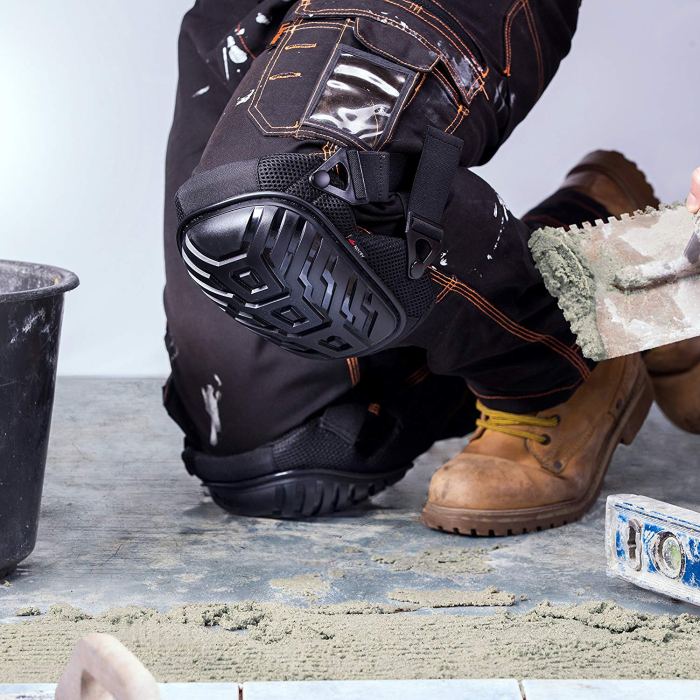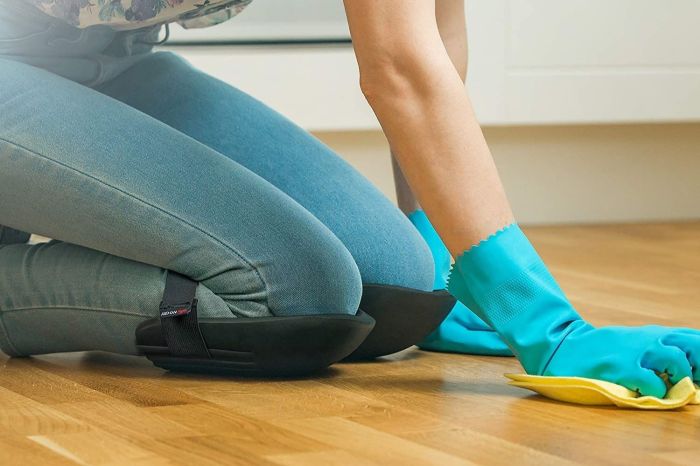Knee Pads Flooring Decor: Transforming mundane knee pads into stylish home improvement accessories. This isn’t just about protecting your knees; it’s about enhancing your flooring’s aesthetic appeal during renovations or DIY projects. We’ll explore the market demand, innovative designs, and effective marketing strategies to turn this functional item into a desirable product. From sustainable materials to targeted marketing campaigns, we’ll delve into every aspect of bringing this unique concept to life.
Market Research

Understanding the needs and preferences of potential customers is crucial for the success of any product, including knee pads designed for flooring installation and decoration. This market research delves into the various factors influencing purchasing decisions, from the types of flooring involved to the aesthetic considerations and the differing needs of professional installers versus DIY enthusiasts.
Types of Flooring Requiring Knee Pads
Knee pads find application across a wide range of flooring types. Hardwood flooring, with its unforgiving surface, is a primary use case. Tile installations, known for their hard and often irregular surfaces, also necessitate knee protection. Laminate and engineered wood flooring, while slightly more forgiving, can still cause discomfort during prolonged installation. Even softer flooring options like carpet, particularly during underlayment installation, can benefit from knee pads to provide comfort and support.
The specific design and padding of the knee pads might vary depending on the flooring type and the nature of the installation. For instance, thicker padding might be preferred for tile installations compared to hardwood.
Target Demographics for Knee Pad Purchases
The demographics most likely to purchase knee pads for flooring decor and installation span a broad range. Professional flooring installers represent a significant segment, given the physical demands of their work. Home improvement enthusiasts and DIYers constitute another substantial group, driven by cost savings and the desire to personalize their living spaces. Furthermore, older individuals, who may experience increased joint pain and discomfort, are likely to find knee pads beneficial for home maintenance tasks involving flooring.
Finally, rental property owners and property managers represent a niche market, prioritizing efficiency and cost-effectiveness in maintaining their properties.
Aesthetic Preferences and Flooring Styles
Aesthetic preferences significantly influence knee pad choices. While functionality remains paramount, color and material can complement the overall flooring style. For example, knee pads in neutral colors like black, gray, or beige would blend seamlessly with most flooring types, while brighter colors might be chosen to match a specific room’s decor. The material itself can also affect the aesthetic appeal; some users may prefer the durability of leather or canvas, while others might opt for the lightweight comfort of neoprene.
The overall design, including features like straps or padding, can also influence the aesthetic appeal and the perceived value of the product.
Professional Installers vs. DIY Enthusiasts: Needs Comparison
Professional installers and DIY enthusiasts have differing needs regarding knee pads. Professionals often prioritize durability and longevity, demanding knee pads capable of withstanding daily wear and tear over extended periods. They may also prefer features like reinforced stitching, adjustable straps, and robust padding for enhanced comfort and support during intensive work. DIY enthusiasts, on the other hand, may focus more on affordability and ease of use, potentially opting for simpler, less expensive knee pads that suffice for occasional use.
The level of protection required also differs; professionals might need more robust protection to prevent injuries, while DIYers may prioritize comfort over maximum protection.
Hypothetical Customer Profile: The DIY Home Renovator
A prime target market segment is the DIY home renovator, aged 35-55, with a household income of $75,000-$125,000. This individual is likely to be a homeowner actively engaged in home improvement projects, prioritizing value and quality but also mindful of budget constraints. They are digitally savvy, researching products online before purchasing, and value customer reviews and recommendations. They appreciate aesthetically pleasing products that complement their home’s decor while providing adequate functionality and protection.
This profile highlights the need for knee pads that balance affordability, durability, and aesthetic appeal to cater to this significant market segment.
Product Design & Features: Knee Pads Flooring Decor

Transforming utilitarian knee pads into stylish flooring decor requires a careful consideration of design, materials, and target audience. The key is to seamlessly blend functionality with aesthetic appeal, creating products that are both practical and visually pleasing. This involves exploring diverse material options, incorporating sustainable practices, and designing styles that cater to different interior design preferences.
Knee Pad Style Variations
Three distinct knee pad styles can be envisioned to cater to a broader market. Each style prioritizes a unique aesthetic and utilizes materials suitable for both comfort and visual impact. These designs aim to elevate knee pads from purely functional items to decorative accessories that complement various home styles.
| Style | Material | Key Features | Target Audience |
|---|---|---|---|
| Modern Minimalist | Recycled felt with a subtle geometric pattern, possibly in muted grey or beige. | Sleek, low-profile design; durable and comfortable; easily integrated into modern interiors; machine washable. | Individuals and families who appreciate clean lines and minimalist aesthetics; those seeking functional yet stylish home accessories. |
| Bohemian Chic | Thick, richly colored cotton patchwork, possibly incorporating embroidery or other embellishments. | Soft, textured surface; vibrant colors and patterns; adds warmth and visual interest; hand-washable. | Individuals with bohemian or eclectic style preferences; those who value handmade items and unique textures. |
| Rustic Farmhouse | Natural, undyed linen or jute, possibly with subtle distressing for a vintage look. | Natural fiber texture; sustainable and eco-friendly; complements farmhouse, rustic, or cottage-style decor; machine washable. | Individuals who appreciate natural materials and rustic aesthetics; those seeking environmentally conscious home goods. |
Features Enhancing Decorative Appeal, Knee Pads Flooring Decor
Beyond basic functionality, several features contribute to the decorative appeal of knee pads. These features transform the product from a purely practical item to a stylish accessory that enhances the overall aesthetic of a room. This focus on design detail is crucial for success in the decorative flooring market.The incorporation of visually appealing patterns, textures, and colors is paramount.
Embroidery, quilting, or even subtle textural variations in the material itself can add depth and visual interest. Furthermore, the size and shape of the knee pads can be carefully considered to complement existing decor. For example, larger, square pads could act as small accent pieces, while smaller, round pads might be used as functional yet decorative elements near a fireplace.
Finally, the choice of materials plays a significant role in determining the overall aesthetic. Natural materials such as linen or jute lend themselves to rustic designs, while modern materials like recycled felt can create a minimalist aesthetic.
Material Selection for Functionality and Visual Appeal
A variety of materials offer both functionality and visual appeal for decorative knee pads. The selection should consider factors such as durability, comfort, washability, and aesthetic compatibility with different interior styles. Sustainable and ethically sourced materials are also increasingly important considerations for environmentally conscious consumers.Examples include: recycled felt (durable, soft, available in various colors and textures); organic cotton (soft, breathable, naturally beautiful); undyed linen (durable, breathable, creates a rustic aesthetic); jute (durable, textured, eco-friendly); and recycled rubber (durable, provides good cushioning).
The choice of material will significantly impact both the functionality and the visual style of the final product.
Sustainable and Eco-Friendly Materials
The increasing demand for sustainable and eco-friendly products presents an opportunity to incorporate environmentally conscious materials in the design of decorative knee pads. Using recycled materials, such as recycled felt or repurposed fabrics, reduces environmental impact and aligns with the growing consumer preference for sustainable goods. This approach not only benefits the environment but also enhances the brand’s image and appeal to environmentally conscious consumers.
The use of organic cotton, undyed linen, or jute are further examples of sustainable materials that can be used. Promoting transparency in sourcing and manufacturing processes will further enhance the product’s sustainability credentials.
Ultimately, the success of Knee Pads Flooring Decor hinges on a blend of functionality, aesthetics, and smart marketing. By carefully considering customer needs, designing appealing products, and employing effective marketing strategies, this niche product has the potential to capture a significant market share. The key lies in showcasing the dual value proposition – protection and style – to resonate with both professional installers and DIY enthusiasts.
The market awaits a stylish solution to a common problem, and Knee Pads Flooring Decor is poised to answer that call.